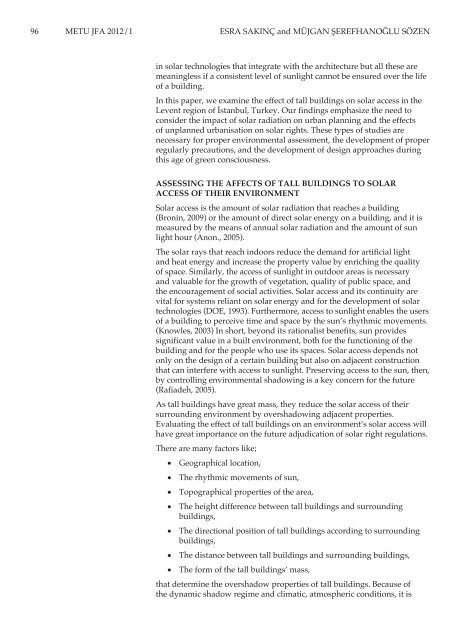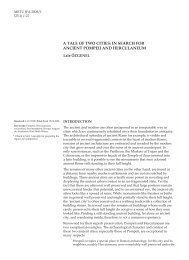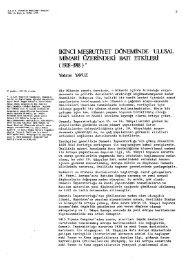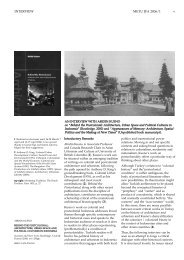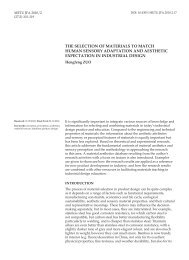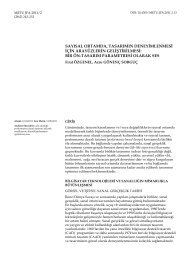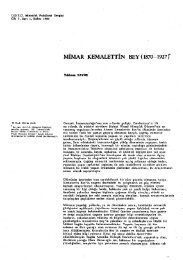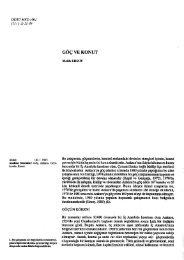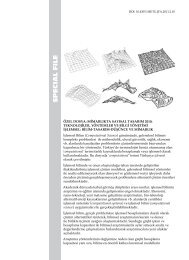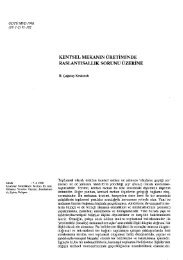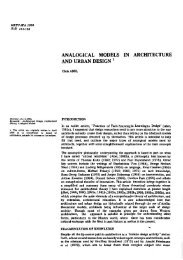the effect of tall buildings on solar access of the environment ...
the effect of tall buildings on solar access of the environment ...
the effect of tall buildings on solar access of the environment ...
Create successful ePaper yourself
Turn your PDF publications into a flip-book with our unique Google optimized e-Paper software.
96 METU JFA 2012/1<br />
ESRA SAKINÇ and Müjgan ŞEREFHanOĞLU SÖZEn<br />
in <strong>solar</strong> technologies that integrate with <str<strong>on</strong>g>the</str<strong>on</strong>g> architecture but all <str<strong>on</strong>g>the</str<strong>on</strong>g>se are<br />
meaningless if a c<strong>on</strong>sistent level <str<strong>on</strong>g>of</str<strong>on</strong>g> sunlight cannot be ensured over <str<strong>on</strong>g>the</str<strong>on</strong>g> life<br />
<str<strong>on</strong>g>of</str<strong>on</strong>g> a building.<br />
In this paper, we examine <str<strong>on</strong>g>the</str<strong>on</strong>g> <str<strong>on</strong>g>effect</str<strong>on</strong>g> <str<strong>on</strong>g>of</str<strong>on</strong>g> <str<strong>on</strong>g>tall</str<strong>on</strong>g> <str<strong>on</strong>g>buildings</str<strong>on</strong>g> <strong>on</strong> <strong>solar</strong> <strong>access</strong> in <str<strong>on</strong>g>the</str<strong>on</strong>g><br />
Levent regi<strong>on</strong> <str<strong>on</strong>g>of</str<strong>on</strong>g> İstanbul, Turkey. Our findings emphasize <str<strong>on</strong>g>the</str<strong>on</strong>g> need to<br />
c<strong>on</strong>sider <str<strong>on</strong>g>the</str<strong>on</strong>g> impact <str<strong>on</strong>g>of</str<strong>on</strong>g> <strong>solar</strong> radiati<strong>on</strong> <strong>on</strong> urban planning and <str<strong>on</strong>g>the</str<strong>on</strong>g> <str<strong>on</strong>g>effect</str<strong>on</strong>g>s<br />
<str<strong>on</strong>g>of</str<strong>on</strong>g> unplanned urbanisati<strong>on</strong> <strong>on</strong> <strong>solar</strong> rights. These types <str<strong>on</strong>g>of</str<strong>on</strong>g> studies are<br />
necessary for proper envir<strong>on</strong>mental assessment, <str<strong>on</strong>g>the</str<strong>on</strong>g> development <str<strong>on</strong>g>of</str<strong>on</strong>g> proper<br />
regularly precauti<strong>on</strong>s, and <str<strong>on</strong>g>the</str<strong>on</strong>g> development <str<strong>on</strong>g>of</str<strong>on</strong>g> design approaches during<br />
this age <str<strong>on</strong>g>of</str<strong>on</strong>g> green c<strong>on</strong>sciousness.<br />
ASSESSING THE AFFECTS OF TALL BUILDINGS TO SOLAR<br />
ACCESS OF THEIR ENVIRONMENT<br />
Solar <strong>access</strong> is <str<strong>on</strong>g>the</str<strong>on</strong>g> amount <str<strong>on</strong>g>of</str<strong>on</strong>g> <strong>solar</strong> radiati<strong>on</strong> that reaches a building<br />
(Br<strong>on</strong>in, 2009) or <str<strong>on</strong>g>the</str<strong>on</strong>g> amount <str<strong>on</strong>g>of</str<strong>on</strong>g> direct <strong>solar</strong> energy <strong>on</strong> a building, and it is<br />
measured by <str<strong>on</strong>g>the</str<strong>on</strong>g> means <str<strong>on</strong>g>of</str<strong>on</strong>g> annual <strong>solar</strong> radiati<strong>on</strong> and <str<strong>on</strong>g>the</str<strong>on</strong>g> amount <str<strong>on</strong>g>of</str<strong>on</strong>g> sun<br />
light hour (An<strong>on</strong>., 2005).<br />
The <strong>solar</strong> rays that reach indoors reduce <str<strong>on</strong>g>the</str<strong>on</strong>g> demand for artificial light<br />
and heat energy and increase <str<strong>on</strong>g>the</str<strong>on</strong>g> property value by enriching <str<strong>on</strong>g>the</str<strong>on</strong>g> quality<br />
<str<strong>on</strong>g>of</str<strong>on</strong>g> space. Similarly, <str<strong>on</strong>g>the</str<strong>on</strong>g> <strong>access</strong> <str<strong>on</strong>g>of</str<strong>on</strong>g> sunlight in outdoor areas is necessary<br />
and valuable for <str<strong>on</strong>g>the</str<strong>on</strong>g> growth <str<strong>on</strong>g>of</str<strong>on</strong>g> vegetati<strong>on</strong>, quality <str<strong>on</strong>g>of</str<strong>on</strong>g> public space, and<br />
<str<strong>on</strong>g>the</str<strong>on</strong>g> encouragement <str<strong>on</strong>g>of</str<strong>on</strong>g> social activities. Solar <strong>access</strong> and its c<strong>on</strong>tinuity are<br />
vital for systems reliant <strong>on</strong> <strong>solar</strong> energy and for <str<strong>on</strong>g>the</str<strong>on</strong>g> development <str<strong>on</strong>g>of</str<strong>on</strong>g> <strong>solar</strong><br />
technologies (DOE, 1993). Fur<str<strong>on</strong>g>the</str<strong>on</strong>g>rmore, <strong>access</strong> to sunlight enables <str<strong>on</strong>g>the</str<strong>on</strong>g> users<br />
<str<strong>on</strong>g>of</str<strong>on</strong>g> a building to perceive time and space by <str<strong>on</strong>g>the</str<strong>on</strong>g> sun’s rhythmic movements.<br />
(Knowles, 2003) In short, bey<strong>on</strong>d its rati<strong>on</strong>alist benefits, sun provides<br />
significant value in a built envir<strong>on</strong>ment, both for <str<strong>on</strong>g>the</str<strong>on</strong>g> functi<strong>on</strong>ing <str<strong>on</strong>g>of</str<strong>on</strong>g> <str<strong>on</strong>g>the</str<strong>on</strong>g><br />
building and for <str<strong>on</strong>g>the</str<strong>on</strong>g> people who use its spaces. Solar <strong>access</strong> depends not<br />
<strong>on</strong>ly <strong>on</strong> <str<strong>on</strong>g>the</str<strong>on</strong>g> design <str<strong>on</strong>g>of</str<strong>on</strong>g> a certain building but also <strong>on</strong> adjacent c<strong>on</strong>structi<strong>on</strong><br />
that can interfere with <strong>access</strong> to sunlight. Preserving <strong>access</strong> to <str<strong>on</strong>g>the</str<strong>on</strong>g> sun, <str<strong>on</strong>g>the</str<strong>on</strong>g>n,<br />
by c<strong>on</strong>trolling envir<strong>on</strong>mental shadowing is a key c<strong>on</strong>cern for <str<strong>on</strong>g>the</str<strong>on</strong>g> future<br />
(Rafiadeh, 2005).<br />
As <str<strong>on</strong>g>tall</str<strong>on</strong>g> <str<strong>on</strong>g>buildings</str<strong>on</strong>g> have great mass, <str<strong>on</strong>g>the</str<strong>on</strong>g>y reduce <str<strong>on</strong>g>the</str<strong>on</strong>g> <strong>solar</strong> <strong>access</strong> <str<strong>on</strong>g>of</str<strong>on</strong>g> <str<strong>on</strong>g>the</str<strong>on</strong>g>ir<br />
surrounding envir<strong>on</strong>ment by overshadowing adjacent properties.<br />
Evaluating <str<strong>on</strong>g>the</str<strong>on</strong>g> <str<strong>on</strong>g>effect</str<strong>on</strong>g> <str<strong>on</strong>g>of</str<strong>on</strong>g> <str<strong>on</strong>g>tall</str<strong>on</strong>g> <str<strong>on</strong>g>buildings</str<strong>on</strong>g> <strong>on</strong> an envir<strong>on</strong>ment’s <strong>solar</strong> <strong>access</strong> will<br />
have great importance <strong>on</strong> <str<strong>on</strong>g>the</str<strong>on</strong>g> future adjudicati<strong>on</strong> <str<strong>on</strong>g>of</str<strong>on</strong>g> <strong>solar</strong> right regulati<strong>on</strong>s.<br />
There are many factors like;<br />
• Geographical locati<strong>on</strong>,<br />
• The rhythmic movements <str<strong>on</strong>g>of</str<strong>on</strong>g> sun,<br />
• Topographical properties <str<strong>on</strong>g>of</str<strong>on</strong>g> <str<strong>on</strong>g>the</str<strong>on</strong>g> area,<br />
• The height difference between <str<strong>on</strong>g>tall</str<strong>on</strong>g> <str<strong>on</strong>g>buildings</str<strong>on</strong>g> and surrounding<br />
<str<strong>on</strong>g>buildings</str<strong>on</strong>g>,<br />
• The directi<strong>on</strong>al positi<strong>on</strong> <str<strong>on</strong>g>of</str<strong>on</strong>g> <str<strong>on</strong>g>tall</str<strong>on</strong>g> <str<strong>on</strong>g>buildings</str<strong>on</strong>g> according to surrounding<br />
<str<strong>on</strong>g>buildings</str<strong>on</strong>g>,<br />
• The distance between <str<strong>on</strong>g>tall</str<strong>on</strong>g> <str<strong>on</strong>g>buildings</str<strong>on</strong>g> and surrounding <str<strong>on</strong>g>buildings</str<strong>on</strong>g>,<br />
• The form <str<strong>on</strong>g>of</str<strong>on</strong>g> <str<strong>on</strong>g>the</str<strong>on</strong>g> <str<strong>on</strong>g>tall</str<strong>on</strong>g> <str<strong>on</strong>g>buildings</str<strong>on</strong>g>’ mass,<br />
that determine <str<strong>on</strong>g>the</str<strong>on</strong>g> overshadow properties <str<strong>on</strong>g>of</str<strong>on</strong>g> <str<strong>on</strong>g>tall</str<strong>on</strong>g> <str<strong>on</strong>g>buildings</str<strong>on</strong>g>. Because <str<strong>on</strong>g>of</str<strong>on</strong>g><br />
<str<strong>on</strong>g>the</str<strong>on</strong>g> dynamic shadow regime and climatic, atmospheric c<strong>on</strong>diti<strong>on</strong>s, it is


